Gustav Stickley, the Arts and Crafts movement & Craftsman-style homes
Stickley was a Wisconsin-born editor, author, publisher, architect, and furniture designer. From the pages of his influential magazine, “The Craftsman,” Stickley shared designs and philosophies that have become the bedrock of this timeless style. This guide aims to explore the detailed world of Craftsman homes, from their origins to their numerous variations. Welcome to a journey through an architectural style where every line, every beam, and every handcrafted element works in harmony to create not just a house, but a home.

What makes a house a Craftsman style house?
At its core, a Craftsman style house is all about simplicity and attention to detail. The Craftsman house is often recognized for its hand-crafted features like built-in cabinets, exposed beams, and charming porches. Exteriors usually feature natural materials like wood or stone. It’s the design that says, “Hey, someone really cared when they put this place together.”
A Craftsman style house plan typically focuses on functionality, an open floor layout, and exterior elements that blend with the surrounding natural landscape. These plans are marked by generous porches and large, tapered columns. Inside, the open floor plans usually connect the living, dining, and kitchen areas to create a comfortable and communal space.
What era is Craftsman style?
The Craftsman style originated in the early 20th century as a backlash against the mass-produced fussiness of the Victorian era. It gained prominence between 1905 and 1930. The style’s roots can be traced back to the Arts and Crafts movement, which emphasized the value of handcrafted quality and materials.
What are the different styles of Craftsman houses?
Craftsman houses don’t come in a one-size-fits-all model. The primary subtypes include:
- Bungalow: A small, single-story Craftsman with a cozy feel.
- Prairie: A subtype often featuring horizontal lines and flat or hipped roofs, borrowing from Frank Lloyd Wright’s designs.
- Mission Revival: Incorporates Spanish architectural elements like arches and stucco exteriors.
- Foursquare: A simple, boxy design with a strong focus on functionality.

What is a Foursquare Craftsman house?
The Foursquare Craftsman is a two-story house, typically square in shape, with a straightforward layout. It’s the no-fuss version of a Craftsman. Practicality reigns supreme here, with a central staircase and rooms branching off a central hall. It’s all about making the most of the available space.
What is the difference between Craftsman and Prairie style houses?
While both Craftsman and Prairie styles emphasize handcrafted details and natural materials, Prairie homes often feature horizontal lines and flat roofs to blend in with the landscape. Craftsman homes, on the other hand, tend to have gabled roofs and are less concerned with blending into their surroundings.
What’s the difference between a Craftsman home and an Arts and Crafts home?
Arts and Crafts is the broader movement that gave birth to the Craftsman style. An Arts and Crafts home may include a variety of styles, not just Craftsman, all of which focus on handcrafted details and artisan work. Craftsman is the more specific American interpretation, rooted in functionality and simplicity.
What is the difference between a bungalow and a Craftsman?
A bungalow is essentially the little sibling in the Craftsman family. It maintains many Craftsman elements like the handcrafted details and natural materials, but usually in a smaller, one-story or one-and-a-half-story layout. The term “Craftsman” is more about the style, while “bungalow” refers to the structure’s size and layout.

Is Craftsman the same as farmhouse style?
Nope, they’re different animals (though you may see modern farmhouse plans categorized under Craftsman, they aren’t technically the same). While both focus on simplicity, farmhouse style leans toward a rustic, country vibe and often features shiplap, barn doors, and more white paint. Craftsman homes focus more on architectural details and natural materials. Of course, you could always build a hybrid of these two styles — you do you!
What style of furniture goes in a Craftsman-style house?
If you’re decorating a Craftsman home, think sturdy, wooden furniture. Arts and Crafts or Mission-style furniture pieces work great. The aim is to maintain that handcrafted, artisanal vibe. Leather and natural fabrics in muted tones complement the wood nicely.
Below, enter the world of these classic Stickley homes, through vintage photographs and architectural drawings created during the first two decades of the twentieth century.
Old Craftsman bungalow with cobblestone foundation and chimney (1915)
Simple but effective woodwork and wide shadowing eaves

Popular vintage Craftsman home design (1912)
Extremely popular design of five rooms on the ground floor, with two bedrooms, one 14 by 14 feet, the other 10 feet 6 inches by 14 feet, and sleeping porch of ample size on the second floor.
The fireplace is enclosed in an inglenook with seats on either side. Large, roomy closets are provided for all the bedrooms, and the bathroom is located convenient to all rooms.
The plan calls for a brick flue in the kitchen for kitchen range and laundry stove. The furnace flue is in the fireplace chimney.

An interesting variation of the “chalet” bungalow style (1915)
See decorative use of timber in the walls and roof.

Craftsman Farms: The home of Gustav Stickley a labor of love, precision (1974)
By Majorie Kaschewski – Daily Record (Morristown, New Jersey) October 20, 1974
Craftsman Farms on Tabor Road was to be a Utopia where the working man could feel pride in his achievements, and would not be a cog in a de-personalizing machine.
It was years ahead of its time.
It was the dream of Gustav Stickley, “editor, author, publisher, architect, furniture and interior designer, owner of stores, mills and factories, leader of the arts and crafts movement in the United States.”
And as is the case with all too many dreams, it died in just a few years.
Stickley was a founder of the type of furniture known — erroneously, it has been said — as ”mission,” of dark wood with plain, straight lines and heavy construction.

The farm in Morris Plains was to be the epitome of Stickley’s beliefs. From 1908-1912, he bought more than 400 acres, including the estate of Homer Davenport, the well-known cartoonist. On the land were to be cottages for male students, which they themselves were to build.
They were to work with instructors and those actually constructing furniture in small groups, in a glorified version of the old apprentice system, but for their own advancement and not that of the ”master.”
The boys would be “strong, individual workers,” not just part of the system.

Stickley, his dream, and his five daughters and son, moved to Morris Plains from his Syracuse home to live in the ”clubhouse,” a huge building of log and stone, with living and dining rooms 60 feet long and 30 feet wide, with wide balconies and eaves, huge fireplaces and built-in furniture.
Much of it was wicker, ”and the chairs seemed to wrap around you.” The house was lit entirely by large, thick, handmade candles, in hand-beaten brass candlesticks.
Also built were two log and shingle cottages, a dairy, silo and huge chicken house.
He described the project in 1908 issue of his magazine, The Craftsman, a highly successful publication. Here in Morris Plains would be revived practical and profitable crafts, blended with small farming.
Milk, eggs and vegetables from Craftsman Farms came in each day by truck to the restaurant that crowned Stickley’s 12-story New York building, a large step for a young man who had started as an apprentice stone mason at 12 years of age.
Gustav Stickley was born in 1858 in Wisconsin, and, still a boy, learned the stonemason trade from his father. He hated it. “It was heavy and tedious, much too hard for a boy my age.”
Still in his teens, Stickley worked in his uncle’s chair factory in Brandt, Pennsylvania, then moved to Binghamton. New York, where, in 1886, with his brothers, Charles and Albert, Gustav turned to manufacturing furniture by hand — chiefly chairs of Windsor and other simple styles.

Gradually, he evolved his own school, naming it ”craftsman” in 1901. A chair, he said, should be ”comfortable, well-made, fine in structure, workmanship, proportion and finish, to harmonize with its surroundings.
His designs ”followed and emphasized the straight lines and plain surfaces,” especially in woods — ”American style from American wood.” He loved the grain of oak particularly which he called the ”Abraham Lincoln of wood,” but also elm, chestnut, maple and beech.
His furniture was practical, lasted forever and was considered ideally suited for rustic surroundings. He never used the term ”mission,” because, he said early Spanish missionaries never really created an architectural métier.
Some decorators objected that his approach was ”a symphony of mud and mustard,” somber and dull in color; that the pieces were too heavy to be moved. Stickley’s interior arrangements were for keeps.
One writer said of him that he had also “brought back the fireplace, had woven romance into lighting fixtures, and peace into ample couches, had promoted casement windows and created the outdoor sleeping porch.” He replaced partitions with wooden slat screens for better air circulation.

For some years, his headquarters was in Syracuse, but in 1913, he opened his piece de resistance, the 12-story building in New York, at 38th Street off Fifth Avenue. It had everything. On the lower floors was his furniture manufactured from wood prepared in his own sawmills in the Adirondacks.
DON’T MISS: See NYC’s stunning historical Fifth Avenue mansions (1890s)
There were displays of textiles, of architecture, gardens and grounds; workshops, magazine offices, drafting rooms, club rooms, a library. a lecture hall. Four floors were given over to 85 display areas for homebuilders’ wares.
The top floor housed his restaurant, where Japanese waiters served fine food, much of it from the Morris Plains farm.

It looked as though he was one man who would realize his visions. Then came disaster.
He had over-extended himself, and in less than two years, his achievement had turned to a nightmare. In March 1915, Stickley was forced to file a bankruptcy petition. In 1917, he sold Craftsman Farms.
There were temporary comebacks, but he never was able to repeat his early success, finally dying in April 1942, when he was 84.
The men he had labored with for many years loved him. Often they had eaten together at the noon break out of their respective lunch pails.
His funeral fell on a workday. The factory at that time was being run by one of Gustav Stickley’s brothers, and their business relations had not been entirely happy. He refused his employees permission to attend Gustav’s funeral.
In a body, the workers walked off the job to pay their last respects to the man who had been their friend.
The school of furniture that had been his trademark has been in eclipse for years, although at one time, it was considered the thrust of the future.
With the current trend toward nostalgia, however, his designs may, like so many turn-of-the-century objects, be rediscovered.

Craftsman seven-room cement house

Craftsman concrete bungalow with pergola porch

Craftsman seven-room house design, with two sleeping porches

A two-story Craftsman home with art glass windows

Antique Craftsman home design (1906)
If any one quality is predominant in the Craftsman House for May, it must be the feeling that it is above all things a home. It is the kind of a house that a plain, honest man would like his children to grow up in and remember all their lives as “home,” for children reared in such surroundings should develop into strong, sincere men and women as naturally and inevitably as plants thrive in good soil.
It has been demonstrated over and over again by psychologists and by students of social science that environment is a matter of the first importance in establishing right standards of living and in the development of character, and the putting into practice of this theory has undoubtedly had much to do with the wave of reform that is sweeping so much of modern thought away from the artificial and back to the simple and strong.
That the home surroundings have the strongest possible influence over character has always been one of the first articles of The Craftsman’s belief and every house designed in our workshops is a fresh declaration of faith.
Plain to severity, this house owes all the beauty it possesses to the materials of which it is built, to the massive simplicity of its construction and to its proportions.
And of these the last is the greatest, for one error in the harmony of these severely straight lines would alter the character of the whole building.
All its friendliness comes from the low, broad effect of the walls — a feeling enhanced by the low pitch of the wide-eaved roof, from the suggestion of shelter and welcome in the porch that seems a link between house and terrace, and in the proportion and grouping of the windows.
With the exception of one casement, these are double-hung with small, square panes in the top sash, and they are proportioned in exact harmony with the lines of the house — low and wide, and with heavy, sturdy frames.
The porch is structurally the most attractive feature to be seen in an exterior view of the house.
The wooden pillars are painted pure white, and are very thick and massive in proportion to their height. The rafters are left in view where they support the roof, and a heavy beam running the length of the porch serves to uphold the rafters.
Square, massive cross beams extend from the pillars to the wall, where the ends are sunk in the framing of the house.
The large, solid wooden posts at the corners of the building are repeated across the front to correspond with each pillar, and the lengthwise beam sunk in the wall at the top of window and door casings ties the whole structure together.

Old Craftsman house with stone block exterior of first floor (1904)

An entrance porch sheltered by copings and flower boxes
DON’T MISS: Civil War-era home designs & floor plans from the 1860s

An outdoor living room can be made of this recessed porch

Half-timber and granite bungalow of large capacity (1912)
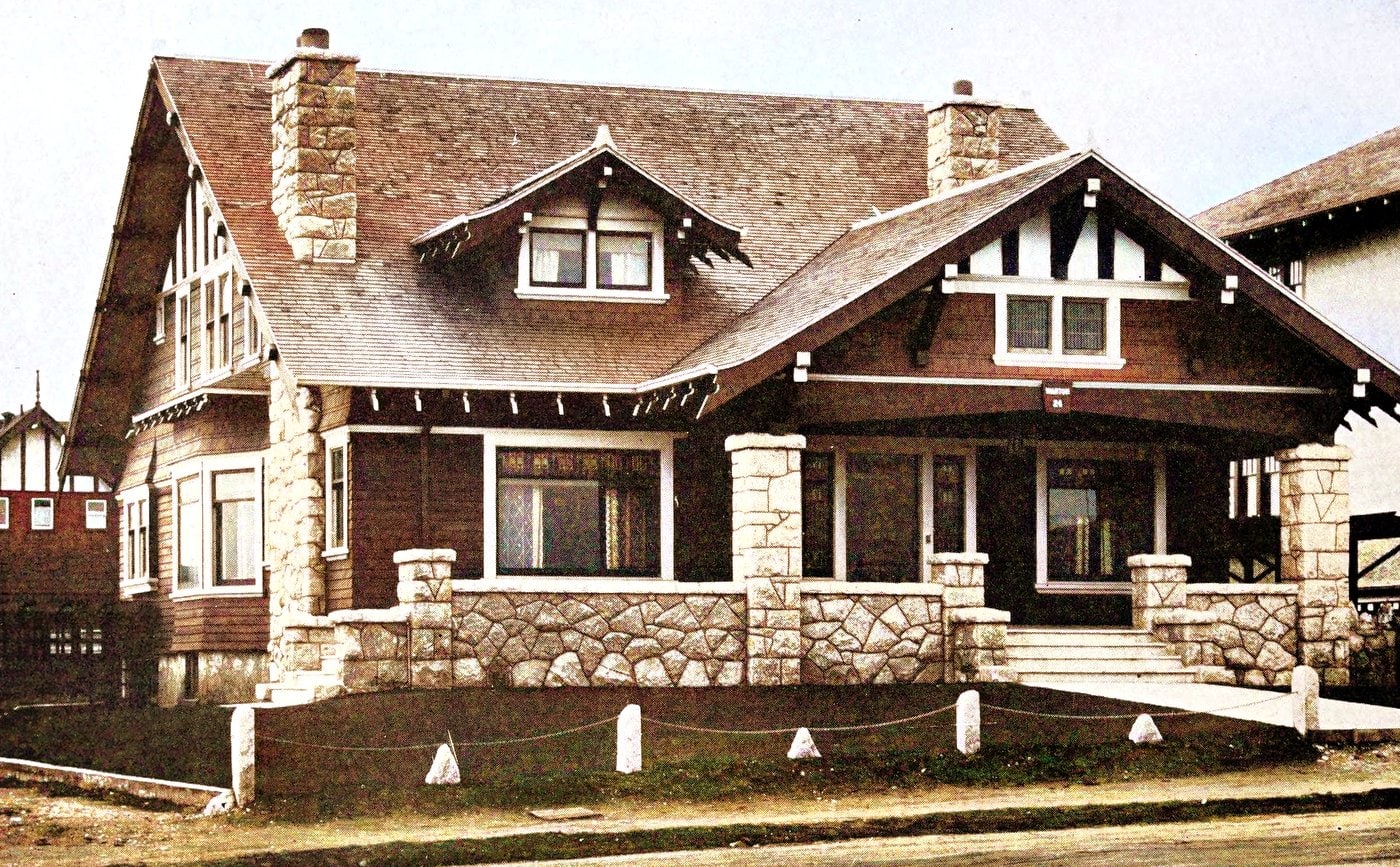
An old Craftsman style home with steep curved roof

A Craftsman city house (duplex)
This Craftsman style home was built on a lot thirty feet wide to accommodate two families.

Stone entrance porch, chimney and ground floor exterior (1908)
Mr Barber’s hillside house in North Adams, Mass., built from Craftsman plans, has a 20-mile view of the Berkshire hills

Rear elevation of above hillside home with four stories (1908)

A substantial cottage with clapboard walls and shingle roof (1908)
ALSO SEE: 9 vintage cottage home plans from 1910

Home with attractive combination of wood and plaster (1909)

Craftsman home built entirely of wood on a stone foundation
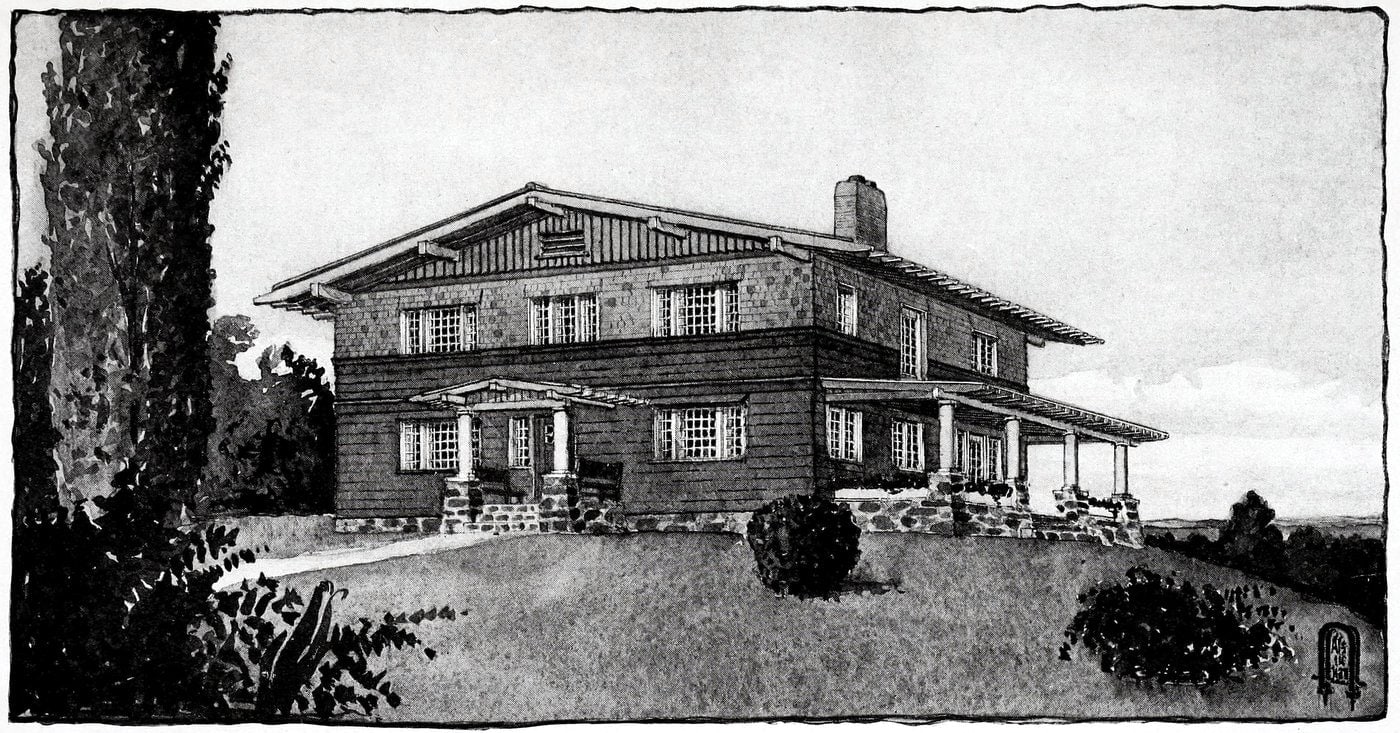
Craftsman house built in New Jersey
Constructed of field stones with heavy lintels of white oak timber.

Craftsman house of stone, cement, and wood
Showing entrance and pergola porch.

Craftsman brick house
Showing a most interesting combination of an entrance and sleeping porch.
ALSO SEE: 20 elegant antique bathrooms from the 1900s: Sinks, tubs, tile & decor

A small California bungalow
Showing the use of red sandstone for the porch pillars, porch foundation, and chimney.

Vintage 1910s bungalow with wood and limestone
An interesting, simple wood construction — with foundation, porch, and porch parapet of white limestone.

A small Craftsman wood cottage
Suited to suburban or country life; Attractive exterior features are the long roof line, the placing of windows, and the picturesque chimney.
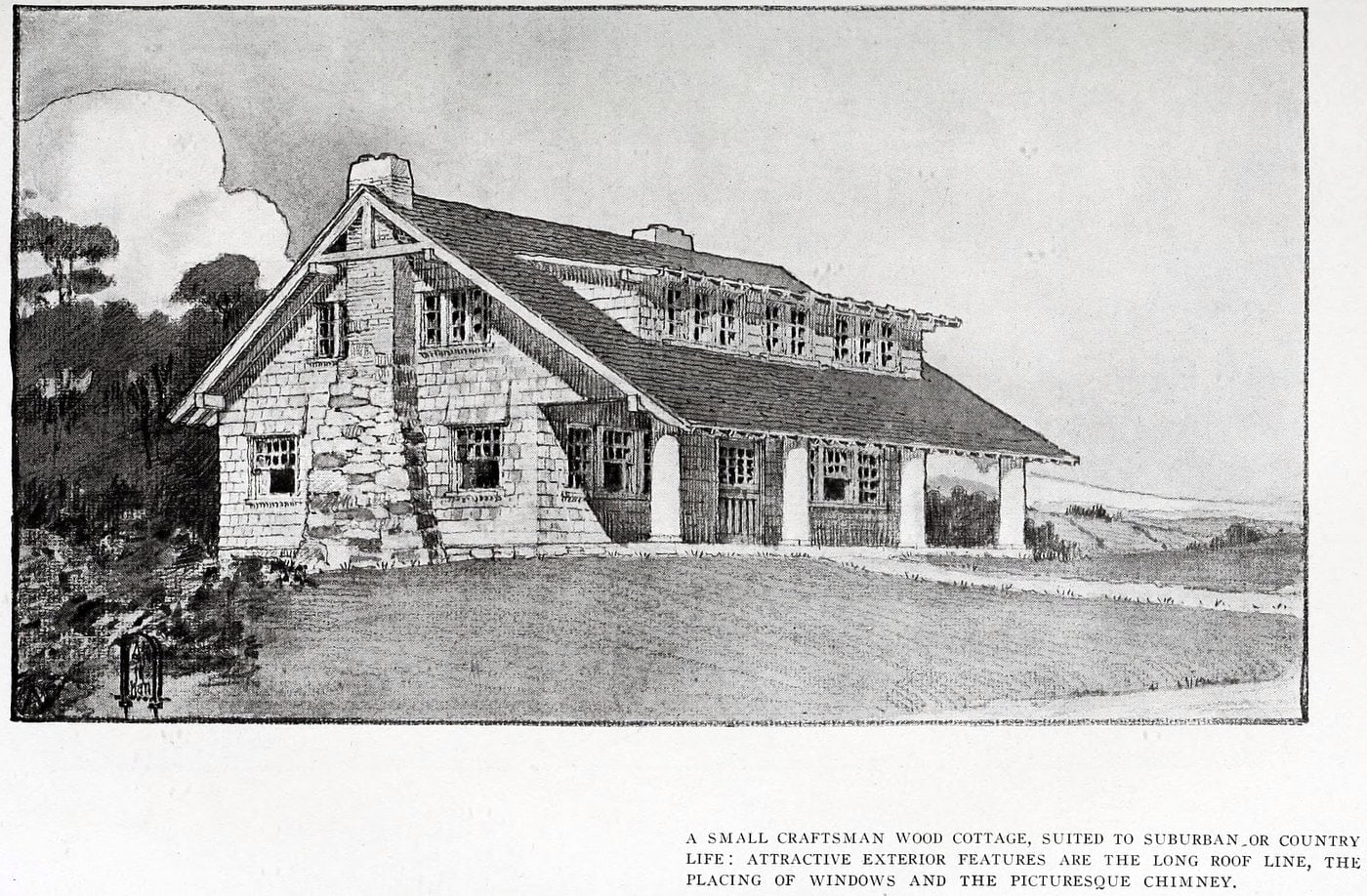
A shingle house with slight suggestion of Swiss architecture in design (1909)

Attractive use of shingles & cement for a large house on the California coast (1910)

House modeled noticeably after Swiss architecture (1909)
While the structural effect is excellent, there is a suggestion of fussiness in the ornamentation.

A house structure made entirely of cement (1910)
Trimmings and supports of wood are used with decorative intent.

A Craftsman house showing the development of a new idea (1910)
A full-width double-height porch fills the front of this home.

A Craftsman design that is especially adapted to cement construction (1910)
DON’T MISS: See some charming & classic All-American suburban houses from 1919

Old-school Craftsman design for shingled house
Showing the decorative effect to be gained by the careful grouping of windows.

Front and back of a vintage Craftsman-style home
(top image) The home of Mr. C.F. Goodfellow, at Northwood, near Stroke-On-Trent, England: Front view.
(bottom image) Rear view of Mr. Goodfellow’s house, showing hedges and garden.
Barry Parker and Raymond Unwin, Architects.
ALSO SEE: See the Vanderbilt Mansion, Biltmore: An American castle in the clouds

Craftsman home turned gymnasium
(top image) Side view of Mr. Steer’s house, showing the entrance to Jiu Jitsu gymnasium.
(bottom image) Good roof lines and interesting grouping of windows is shown in this view.

Craftsman home of split stone and shingles

Photographs of Craftsman home in New Jersey
Two views of the house of Mr. B.A. Taylor, Beechwood Park, Summit, N.J, showing the entrance and living porch at the side.

California bungalow worth studying
Bungalow in Pasadena, California, designed by Edward E. Sweet.
SEE MORE: Beautiful pictures of old Pasadena from the days before cars

6-room bungalow, costing $3,600

Craftsman-style house design for an 8-room bungalow

Brick Craftsman home with sloping staircase entrance
Designed by Gustav Stickley (Architect).

Old Kentucky home from 1912 with Craftsman characteristics
R. Chas. F. Strassner, of Frankfort, Kentucky, writes us that it was nearly a decade ago that he saw in The Craftsman — the design of just the house he desired.
And though not ready to build at that time, he carefully kept the picture and later had the ideas incorporated in his home, which we illustrate here, in which he feels much satisfaction and some pride; in generous appreciation he allows us a share in these.
While not typically a Craftsman house, it has Craftsman characteristics that easily harmonize with the buildings of a different type around it, as shown in the illustration.
Mr. Strassner is to be congratulated upon securing a site so admirably suited to accommodating his residence to advantage, both for itself and the neighboring houses.
It is one of those homes which seems to have grown under the protecting trees that shelter it; to have materialized because of their friendliness and of the sense of permanence they offer. So it should be.
The stone foundation, walls and chimney here further express that which will endure, security, an abiding place; while the lighter shingled superstructure, having many windows and a roof with dormers, relieves it of any somberness, and gives to the whole a thoroughly homelike appearance.
The low front veranda, with its wide steps and substantial pillars, at once welcomes you, extending the hospitality you feel sure of finding under this roof. Being partially shielded by the stonework, and further screened by luxuriant ferns, this broad porch is a most inviting place in summer. Simplicity has been considered in the interior in woodwork and wall treatment.
The color schemes chosen produce such cheerful and desirable effects as to influence one’s sense of harmony. The wood-work of the first floor is oak, stained a dark brown; its beauty of grain and finish, the proportions and simplicity of the door panels and trim, newel post and stairway, lend dignity to the interior.
The floors are quarter-sawed white oak and the walls are finished in rough plaster. The upper and lower halls have buff-tinted walls, reflecting the light, and a stained-glass window on the landing shows soft brown, green and yellow tones. The living room is done in gray-green, a restful shade.

Another view of the above Strassner home
This photo shows the interesting wall (along the sidewalk) in harmony with stone foundation (1912)

A large symmetrical two-family home design
Affording an opportunity for economy of construction without loss of architectural beauty (Number 151)

A concrete Craftman house, planned for simplified housekeeping

“Dumblane,” the Washington home of Mr. & Mrs. S Hazen Bond

Craftsman shingled house (1912)
Home with hooded casement windows, pergola over the entrance, and a long sheltered sleeping balcony. (Plan No 155)

Exterior of a shingled Craftsman house (1912)
The wide eaves, long dormer, small-paned casement windows, and fieldstone pillars, chimney and wall — while all practical parts of the construction, give the house a very homelike, picturesque air.
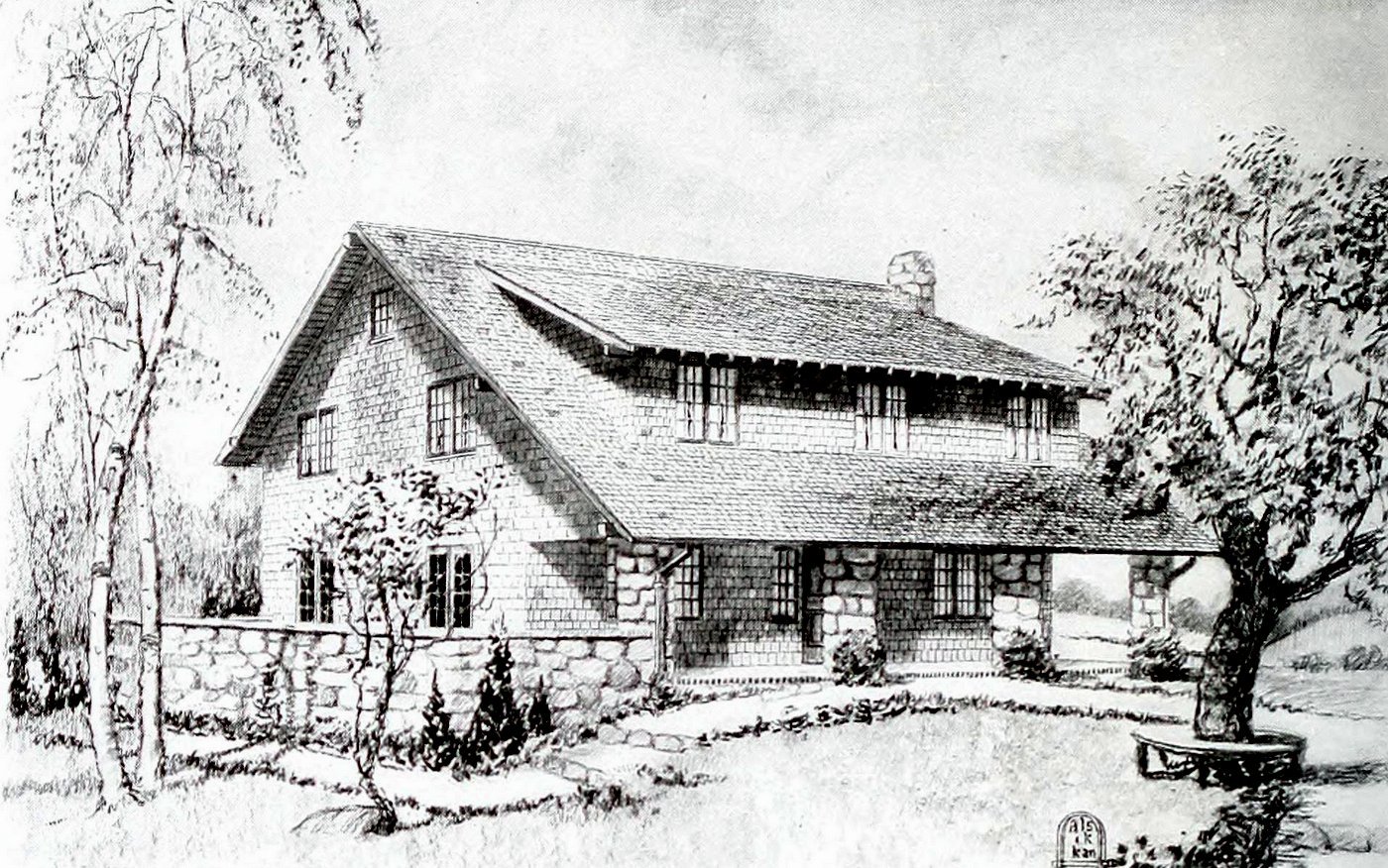
Eight-room Craftsman house
For commodious suburban living; two and half stores of concrete and single. (Architect: Gustav Stickley)

Cement and stone Craftsman house
Eight rooms, two porches and loggia. (Architect: Gustav Stickley)

raftsman brick house (1912)
With eleven living rooms, conservatory, porches, storage rooms and two bathrooms (No. 153)
ALSO SEE: Find out about old-fashioned mansard roof homes & Second Empire-style houses

An authentic Craftsman shingled cottage design (1914)
An economical and comfortable seven-room dwelling intended for a narrow lot, and planned for a family with one maid. In addition to two downstairs porches, there is an upstairs sleeping porch at the rear.

Original Craftsman six-room shingled cottage (1914)
The roof lines, casement windows, recessed porches and tiny balcony give this building a home-like air. (Design 188)

Original Craftsman house, designed by Gustav Stickley
Craftsman house no. 189, of stucco on hollow tile with shingled roof, designed for a woodland site in Palos Park, Illinois, from sketches sent us by the owner.
Among the interesting features of the exterior are the hooded entrance porches, the upstairs sleeping porch on the right and the big outdoor living room with balcony above it, a glimpse of which is seen on the left.
Gustav Stickley, Architect

Craftsman house of brick with shingle roof, designed by Gustav Stickley (1914)

Original Craftsman fieldstone bungalow, front view (1914)
A spacious, comfortably planned and well-equipped home, especially suitable for country surroundings.
The most attractive and unusual feature is the central glass-covered court or garden around which the other rooms are planned, and which provides a delightful place for semi-sheltered living in summer; in winter it can be used as a sunroom. (Designed by Gustav Stickley – Design no. 195)
MORE: Post-war housing: See 35 small starter homes from the ’40s & ’50s

Original Stickley-designed bungalow, back view (1914)

A classic Craftsman two-story shingled cottage
MORE WOOD STYLE: How Dave Brubeck – Mr Jazz – lived in a tree house home

An interesting example of brick and cobblestone for a Craftsman-style house

Shingle-thatched roof Craftsman home
The brick walls, stone-floored terrace and “shingle-thatch” roof on this house at Lake Forest, Illinois, show an exceptionally charming combination of materials; Albro and Lindenberg were the architects.

Retro Craftsman home with stepping stone pathway
An informal stepping-stone pathway across the lawn, that is especially appropriate for the approach to a side door or garden gateway; in this case the pathway leads to D.R. Gamble’s home in Pasadena, of which Greene and Green were the architects.

Bungalow with a second story enclosed sleeping room and open porch (1915)

Bungalow with a large room on the second story (1915)
The big upper room in this home might be used as a living room, nursery, or for sleeping purposes. The roof construction suggests Swiss influence.

Front view of a Craftsman log house
Designed and built by Clark Woodward, the owner.

Oregon bungalow from craftsman ideas: Interesting plan for a side hill
Home of F. E. Watson, Ashland, Oregon, adapted from craftsman plans
To the publisher, The Craftsman,
Dear Sir: As our home owed its inspiration almost entirely to The Craftsman, we have thought you might be interested in the views, floor plan and description of our six-room bungalow in Ashland, Oregon.
This house is a bungalow within and a story and a half cottage without, that is, our living rooms are all on one floor, but we have, in addition, a large and well lighted attic and basement. Our building site is unique, being on the shoulder of a rather steeply sloping hillside.
This location presented practical difficulties, but has proved to have also practical advantages, the basement being well lighted and airy ; and the first floor, the living part of the house, being raised above the ground on the sloping side to the height of an ordinary second story.
[Photo] shows the deep concrete basement on the “down” side, with door and windows; also, the pergola and the balcony above which opens from the dining room and affords opportunity for al fresco eating.
The exterior is of rough-siding, stained gray, with shingle gables stained brown and shingle roof stained tile-red. The front porch, basement walls and retaining wall are all of gray concrete.

Craftsman bungalow with open court

Craftsman house with ivy-covered sleeping porch

Craftsman brick house
With porch, balconies, and sun room.
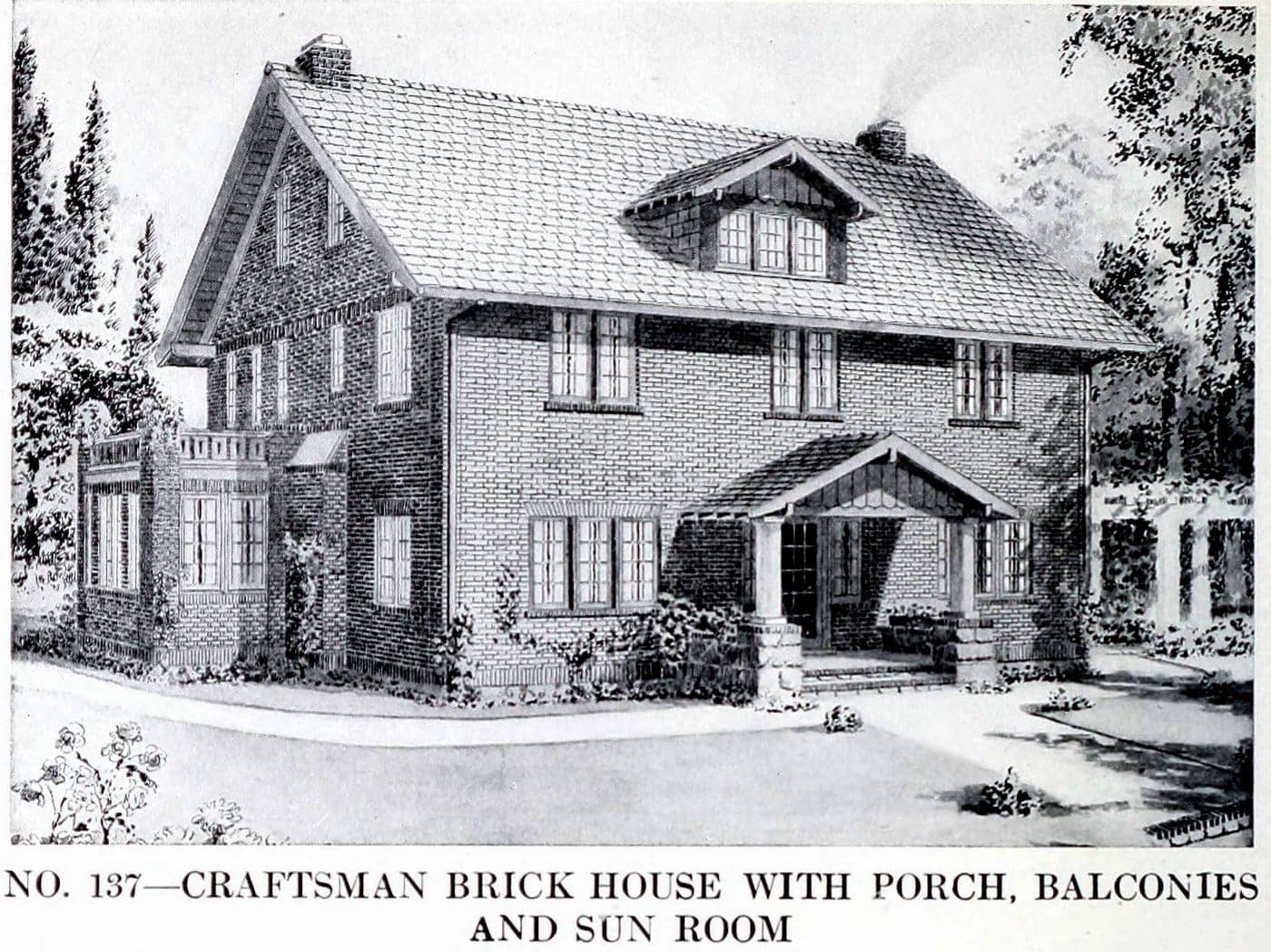
Well-gardened Craftsman home in California
Good examples of California methods of uniting home and garden in friendly intimacy: Both are informal, graceful, and altogether suitable.

Five-room Craftsman shingled bungalow
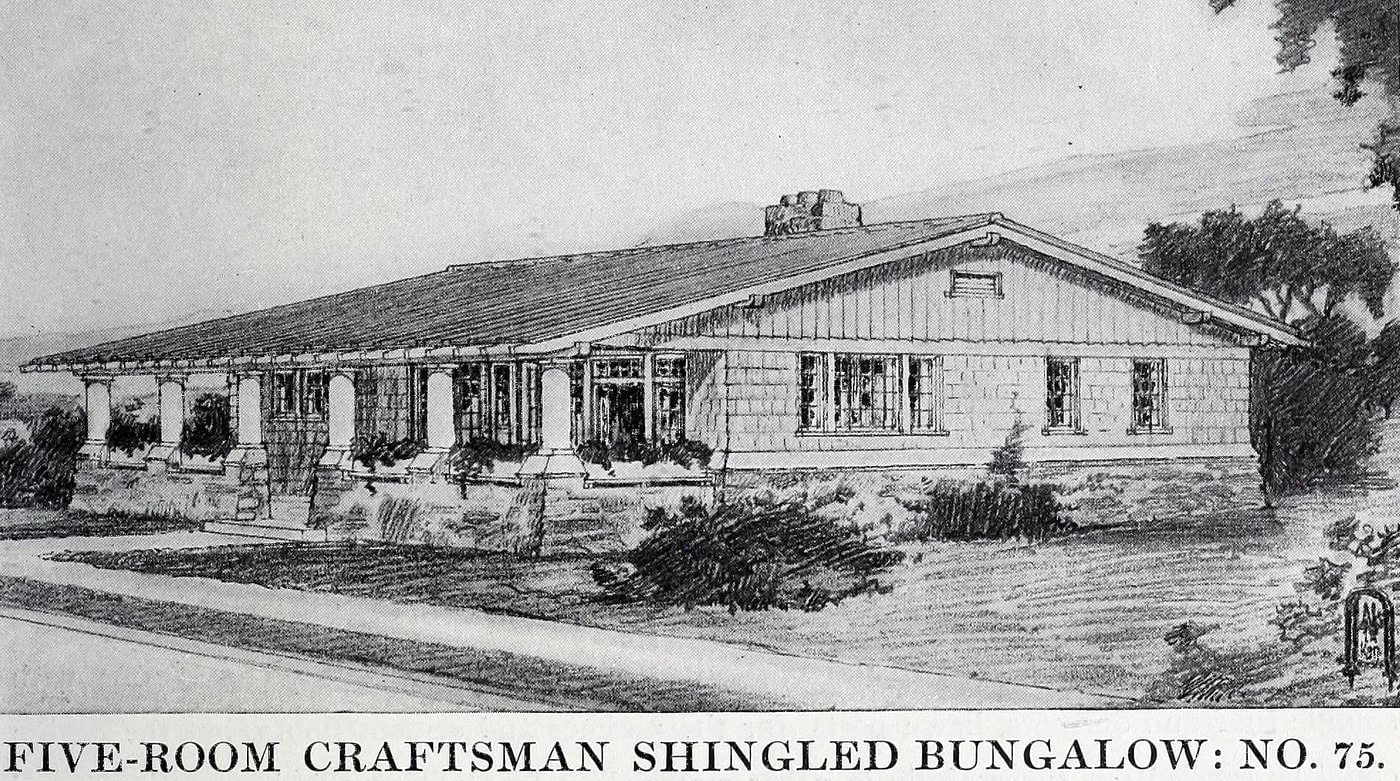
Six-room Craftsman shingled cottage

NOW SEE THIS: 62 beautiful vintage home designs & floor plans from the 1920s




















One Response
Many of these houses don’t look much different from houses being build today, despite being more than a century old.